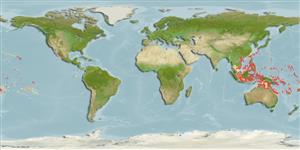>
Eupercaria/misc (Various families in series Eupercaria) >
Labridae (Wrasses) > Corinae
Etymology: Halichoeres: Greek, als, alis = salt + Greek, choiros = pig (Ref. 45335).
More on author: Bleeker.
Environment: milieu / climate zone / depth range / distribution range
Ecologia
marinhas associadas(os) a recifes; intervalo de profundidade 2 - 40 m (Ref. 9710). Tropical; 30°N - 24°S
Western Pacific: east to Samoa (Ref. 27362) and Tonga (Ref. 53797).
Tamanho / Peso / Idade
Maturity: Lm ? range ? - ? cm
Max length : 13.0 cm SL macho/indeterminado; (Ref. 9823)
Descrição suscinta
Chaves de identificação | Morfologia | Morfometria
Espinhos dorsais (total) : 9; Raios dorsais (total) : 12 - 13; Espinhos anais: 3; Raios anais : 12; Vértebras: 25. Anterior head and body color of adults in life bluish gray, shading posteriorly to yellowish; scales often with orange-yellow vertical lines; a dark spot posterior to dorsal half of eye; dorsal fin with a large black spot edged with blue. Anterior lateral line scales with 1-3 pores; 9-11 suborbital pores. Anterior dorsal and anal soft rays longer than posterior rays; pelvic fins of males and large females very long, reaching posterior to anus, often to or beyond origin of anal fin. Juveniles with 4 black stripes on head and body.
Inhabits lagoon and seaward reefs, in coral-rich areas (Ref. 9710). Also found along drop-offs on the bottom of large caves. Usually seen solitary (Ref. 48636).
Ciclo de vida ou comportamento de acasalamento
Maturities | Reprodução | Spawnings | Egg(s) | Fecundities | Larvas
Distinct pairing during breeding (Ref. 205).
Randall, J.E., G.R. Allen and R.C. Steene, 1990. Fishes of the Great Barrier Reef and Coral Sea. University of Hawaii Press, Honolulu, Hawaii. 506 p. (Ref. 2334)
Status na Lista Vermelha da UICN (Ref. 130435)
Ameaça para os humanos
Harmless
Uso pelos humanos
Pescarias: espécies comerciais; Aquário: Espécies comerciais
Ferramentas
Relatórios especiais
Baixar XML
Fontes da internet
Estimates based on models
Preferred temperature (Ref.
123201): 25.4 - 28.9, mean 27.7 °C (based on 332 cells).
Índice de diversidade filogenética (Ref.
82804): PD
50 = 0.5000 [Uniqueness, from 0.5 = low to 2.0 = high].
Bayesian length-weight: a=0.00955 (0.00451 - 0.02020), b=3.09 (2.92 - 3.26), in cm total length, based on LWR estimates for this Genus-body shape (Ref.
93245).
Nível Trófico (Ref.
69278): 3.5 ±0.5 se; based on size and trophs of closest relatives
Resiliência (Ref.
120179): Elevada, tempo mínimo de duplicação da população menor que 15 meses (Preliminary K or Fecundity.).
Fishing Vulnerability (Ref.
59153): Low vulnerability (10 of 100).
Nutrients (Ref.
124155): Calcium = 91.1 [53.6, 154.4] mg/100g; Iron = 0.73 [0.43, 1.35] mg/100g; Protein = 18.4 [15.5, 20.5] %; Omega3 = 0.164 [0.103, 0.259] g/100g; Selenium = 23.7 [14.0, 42.7] μg/100g; VitaminA = 162 [49, 598] μg/100g; Zinc = 1.8 [1.2, 2.9] mg/100g (wet weight);
